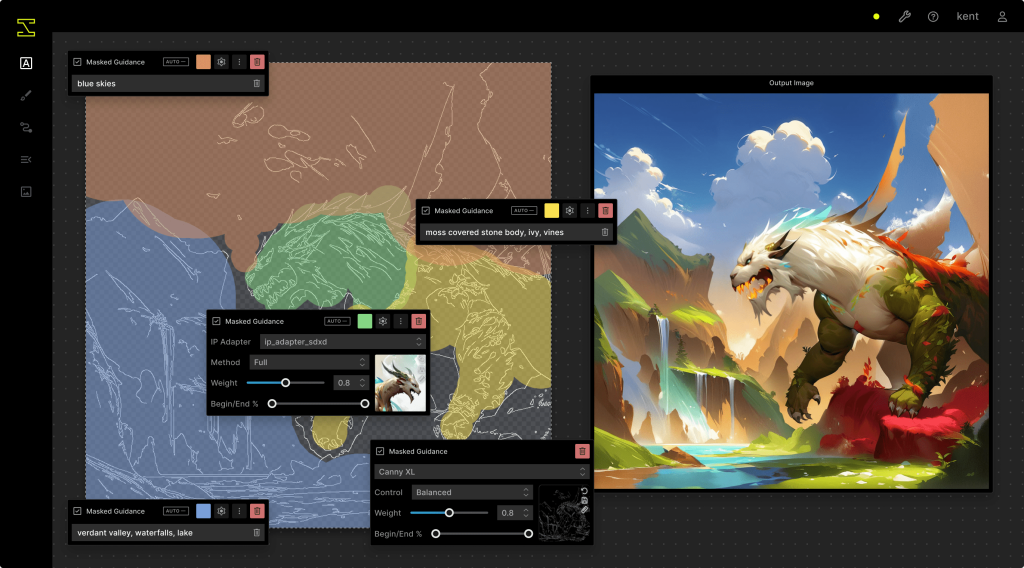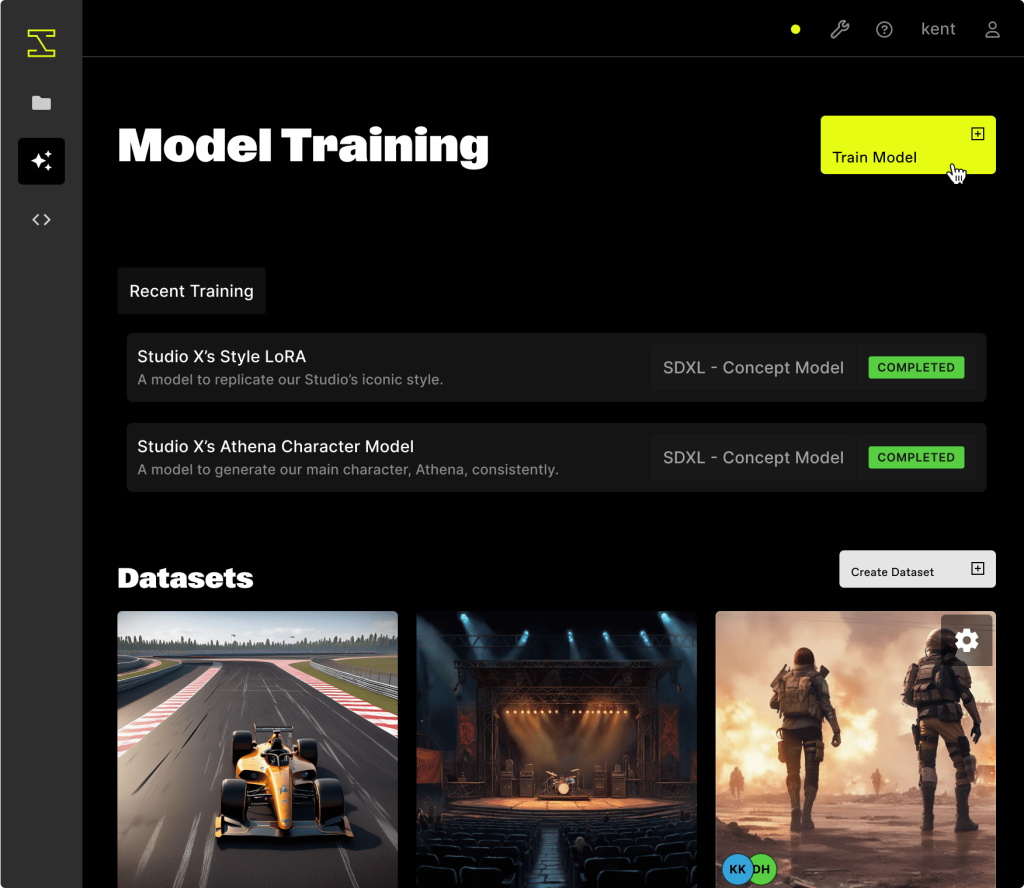Overview
Artificial Intelligence (AI) has been around as long as the game industry. However, in the past 2 years there has been an explosion of interest in generative AI (GenAI). Generative AI is focused on creating content. By taking existing data and analyzing it, GenAI can produce new content customized to user prompts.
Long term, GenAI will impact all industries, but it already has major applications for any content creation including video games. DFC Intelligence believes that over the next few years GenAI will revolutionize both the game development process, and further down the road, the way consumers interact with games.
A major portion of DFC research is currently focused on understanding the landscape and trends in the GenAI space. As part of this process we are talking to leaders in the space to understand the current state of the market and the vision for future growth.
Invoke is a generative AI platform for game developers and professional studios to create visual media. In September 2023, Invoke raised a $4 million seed fund from Storm Ventures and SignalFire.
Recently DFC talked to Invoke founder Kent Keirsey to get his take on the GenAI landscape.

Hello Kent, can you give us an overview of your background and how you came to start Invoke.
I’ve been playing with technology since I was a kid. I grew up learning and working with a wide set of creative tools because my dad was an architect, and then because of my passion for gaming. That tinkering eventually grew into a career in product management, building technology to solve people’s problems. From there, I became fascinated with AI and how it could be used in the gaming industry. This married two of my passions: tinkering with tech and video games. What’s a better job than that?
How did this all happen? I was an early member of a project that grew into prominence in the image generation space because of its focus on artists and creatives – that project became Invoke. I founded the company to expand the scope of ambition for the project in 2023.
Over the past year or so there have been all kinds of generative AI tools hitting the market. Can you describe the competitive landscape? How is Invoke positioned?
The competitive landscape is saturated in almost every dimension. Technology has hit an accelerating rate of advancement while simultaneously becoming widely diffused through open-source tools. There are providers working to build the best centralized AI model, improving their model quality by leveraging usage data to optimize the performance of their model. The open-source ecosystem innovates by experimenting and researching techniques to improve the capabilities of the technology using open model weights, and these make their way into the market of tooling available.
Invoke subverts the positioning of most AI technology companies looking to sell model access by building software for organizations looking to customize and develop their own AI model weights and assets, and helping solve the technology problems associated with training and deploying those to organizations. We do not train proprietary models using customer data, making us the obvious choice for Enterprise organizations.

What is the business model for Invoke?
Our software is open-source, which means we make available our core studio software to enable creatives of all levels, from amateurs to professionals, to explore the creative potential of leveraging AI in their projects.
This approach has driven our user base to hundreds of thousands of people, who not only become internal evangelists for our tools, but help to simplify proof of concepts inside of organizations.
Then, when those organizations are looking for scaled deployment solutions and advanced training solutions? We already have an “inside person” who can help drive them to engage with us at a company level.
From there, we help deploy our software to the organization, at scale, as a hosted cloud solution that provides a secure environment for collaboration. Finally, we advise organizations on strategy, as well as facilitating workflow and model development to optimize solutions for their use-case.
How can creatives use GenAI to create visual assets? Does GenAI enhance the creative process or does it start to replace the human creative component?
What began as a simple “text to image” workflow has evolved rapidly as the technology has developed, with the open-source ecosystem pioneering many new ways of creative control.
With the latest developments, creatives can effectively and efficiently train models to understand their visual language, and then utilize tools like the Invoke studio to take their own work (sketches, renderings, etc.) to control the generation process. These tools allow users to accelerate a creative process that is very much their own. While I anticipate that there will be use cases where the human creative component will be replaced by AI tools, I expect this will largely end up being mostly in consumer use cases.
IP protection seems to be a major issue when it comes to GenAI. How big an issue is it? Does Invoke do anything to help ease developer concerns around these issues?
It’s a massive issue, primarily because of the lack of clarity availed to organizations on both the viability of the many models currently being utilized in the market and the handling of works produced with the assistance of GenAI.
While many legal scholars are advising that training models will be likely deemed ‘fair use’ in the US, there is much less clarity on the copyrightability of resulting outputs.
While there isn’t clarity with respect to where copyright will be granted in AI-assisted works, there is a growing and developing set of precedents demonstrating that human expression involved upstream (in original conception, sketches, etc.) and in the selection and arrangement of assets (such as in tools like Invoke’s canvas) will ultimately be a necessary component to protecting resulting works.
Invoke serves as a partner in addressing these concerns, and is building a foundational set of tools that will help developers capture important metadata in order to demonstrate human expression in the creation of new works.

What are current major limitations around the use of GenAI in game development? How do you see those being addressed going forward?
The current limitations are primarily around legal lack of clarity (see above), which can create resistance use cases in larger organizations to aspects of the process with sufficient confidence in IP protection, and the challenge of large-scale change management. Leveraging these tools requires a more formalized and structured approach to managing data/asset management (specifically with the purpose of training models) and making dramatic changes to art pipelines and processes to leverage the benefits of these tools.
Organizations have been experimenting with these tools over the past year, and are beginning to deploy them more broadly across their studios/teams as these challenges are addressed.
Beyond using GenAI as a game development tool how do you see it rolling out to enhance the end-user experience? Looking 5 years down the road will a company like Invoke be providing tools that allow for living games where users enhance their own experience and or the game state constantly changes based on GenAI?
We are at the genesis of a new form of content – generative media. While one aspect is gaming, I anticipate that we’ll be witnessing a pretty dramatic shift in the landscape of how content is interacted with and consumed.
The extent to which this will be incorporated into games is likely going to differ – a spectrum of integration from fully generative experiences to traditional gaming experiences crafted with AI-supporting tools.
Invoke’s role will be helping organizations develop and hone generative models to support the process of generative media, with deployment solutions available to incorporate these workflows into the varied experiences that the models are endeavoring to serve.
What are the major roadblocks and learning curves in the growth of AI?
Primarily the many misconceptions that have arisen around AI. That is by far our biggest obstacle – the tech is pretty powerful and works pretty well now, and it’s only going to continue getting better. But unless industries become less scared, that won’t matter. Organizations need to begin to develop a stronger understanding of AI model development, deployment, and security.
A couple of notable misconceptions that must be addressed include people treating “prompts” as singularly valuable, when in reality there is a distinct relationship between individual models and the prompts utilized to leverage those models effectively.
Further, individuals looking to leverage these tools are being asked to make dramatic changes to their workflows in order to realize the benefits of these tools – Which pose both a roadblock for organizational adoption, as well as an opportunity for those individuals who rapidly experiment and begin to champion these tools.
As the tools develop, new developments often extend or build upon that existing base of knowledge, providing an advantage to early adopters.
If you are advising a small or medium size game developer how would you tell them to look at the future of GenAI? What should they be doing right NOW? What should they be planning for coming in 5 to 10 years?
GenAI is a tool that has the potential to allow for small/mid-size studios to take on projects of a more ambitious scope than they might have thought ever possible before. They should be working to rapidly experiment and deploy these tools in their development process in order to determine where and how it can amplify the creative capacity of their best talent.
While the tools today offer significant promises, they should also balance that aspiration with the realities that human talent is very much a critical role – while generative AI can amplify talent, it has a particularly uncanny ability to highlight incompetence and lack of taste of those who use it indiscriminately.
Thank you for your time. Please feel free to add any crucial insights you think should be addressed.
The major element to consider with respect to AI models is primarily where and how the technology will be leveraged in the operation of the business. Using closed models from AI vendors is treating AI as a service, whereas models that are developed and owned internally are assets.
With this implication, I fully expect businesses to begin to develop their IP with these generative models taken into consideration. IP that is expected to have a long legacy with multiple titles will likely see increasingly more investment in developing and leveraging AI systems/models that support subsequent projects. This may result in larger publishers developing this as a key aspect of strategic decision-making as they plan projects in the future.

